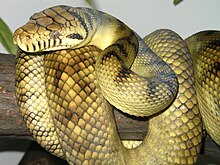Morelia amethystina
| Morelia amethistina | |
|---|---|
 |
|
| Scientific classification | |
| Kingdom: | Animalia |
| Phylum: | Chordata |
| Class: | Reptilia |
| Order: | Squamata |
| Suborder: | Serpentes |
| Family: | Boidae |
| Genus: | Morelia |
| Species: | M. amethistina |
| Binomial name | |
|
Morelia amethistina (Schneider, 1801) |
|
| Synonyms | |
|
|
Morelia amethistina is a nonvenomous species of snake, known as the amethystine, scrub python, or sanca permata locally, found in Indonesia, Papua New Guinea, and Australia. Popular among reptile enthusiasts, and noted for its coloration and size, it is one of the six largest snakes in the world, as measured either by length or weight, and is the largest native snake in Australia and Papua New Guinea. Currently, four subspecies of the nominate race, M. a. amethystina, are generally recognized. The Mollucan Islands, including Halmahera, Ternate, and Tidore, are home to M. a. tracyei. The Tanimbar Islands are home to a smaller subspecies, M. a. nauta. On the island of Seram, M. a. clastolepis can be found, and mainland PNG (including the Indonesian western half, once called Irian Jaya—now West Papua) and many of its near offshore islands, M. a. amethystina is quite common. In Australia, M. a. kinghorni is represented.
Specimens have reportedly been measured at more than 8.5 m (27.9 ft) in total length, but this is exceptional, as 5 m (16.4 ft) specimens are already considered large. As is typical for very large constricting snakes, almost no verified specimens of this species have exceeded 6 m (19.7 ft). However, in 1990, while conducting a herpetological survey, Tom Mendelson collected a wild female specimen on Biak Island, far Eastern Indonesia, which measured 22 feet 7 inches. Another huge female, in a report considered reliable by the staff of the Guinness Book of World Records, was measured by S. Dean in 1954 as 7.2 m (23.6 ft). A typical adult specimen will measure around 2 to 4 m (6.6 to 13.1 ft). Females typically weigh around 15 kg (33 lb). Some exceptional specimens have been confirmed to weigh over 30 kg (66 lb) and unconfirmed outsized specimens have been reported to scale 90 kg (200 lb), although no specimen of this enormous size has been authenticated. Males are much smaller and slimmer, averaging at 5.1 kg (11 lb) at maturity, and occasionally weighing upwards of 11 kg (24 lb). The body is relatively slim, unlike those of many other large members of this family.
The specific name, amethistina, is an allusion to the milky iridescent sheen on its scales, which gives it an amethyst-like color.
...
Wikipedia

